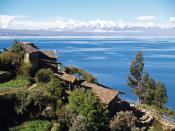Culture of Bolivia
The culture of Bolivia has been shaped and molded over many centuries. The technologically advanced civilization of the Altiplano was the first to occupy this region followed by the Quechua-speaking Indians of pre-Columbian times. After the discovery of America, the Spaniards intermixed with the Aymara, Quechua, and Guarani Indians who were indigenous to the region of Bolivia. This interaction changed the face of Bolivian culture forever. New religions and social hierarchies were established that remain in tact today. The culture of Bolivia can be described by its ethnic groups and the way those groups interact with society.
There are approximately thirty-six indigenous groups found in Bolivia, however, most of them are Aymara, Quechua, and Guarani. They make up roughly 56% of the population. The other 42% are of European decent and mixed(www.state.gov). There are three distinct social groups found in Bolivia. These are the ruling class of whites, the middle class of cholos and the lower class of Indians.
Historically, Bolivia has been controlled by the white minority, which constitutes about fifteen percent of the population. Many of the mixed families that have attained wealth and social prestige have intermarried with the white families and in time have been accepted into the social elite. The cholo are the mixed people of "near-native" decent that are financially comfortable and usually hold positions above those of the Indian manual laborer assuming they are accepted into the upper class(Osborne, 93). The Indians are confined to becoming nothing more than a manual laborer. They are the lowest level of society in Bolivia. They are perceived in Bolivian society as ignorant and incapable of advancement. They seem to have alcohol and cocaine problems and are an economic deadweight. This is not an irrational label. Most of the Indians are subsistence farmers that...


